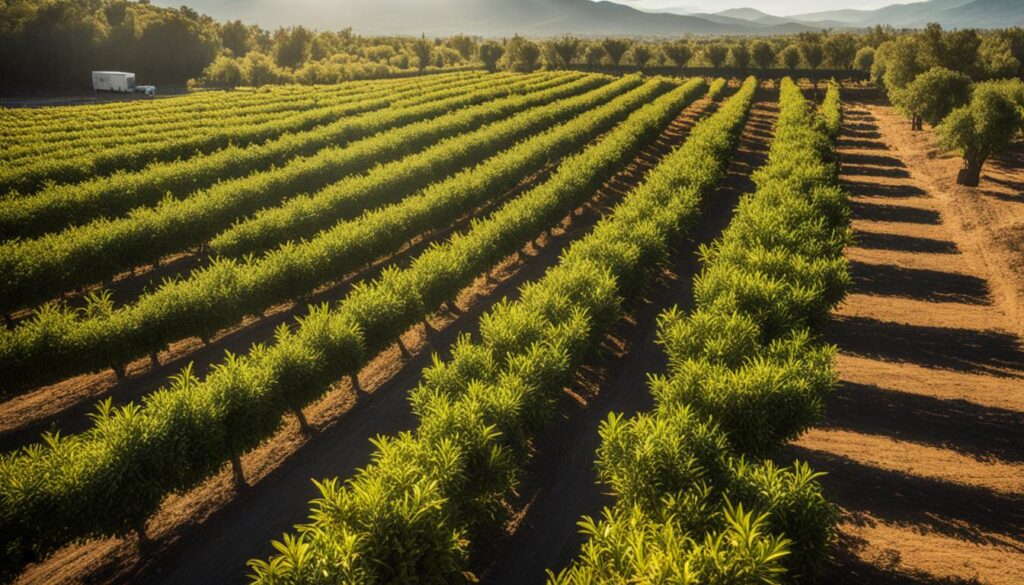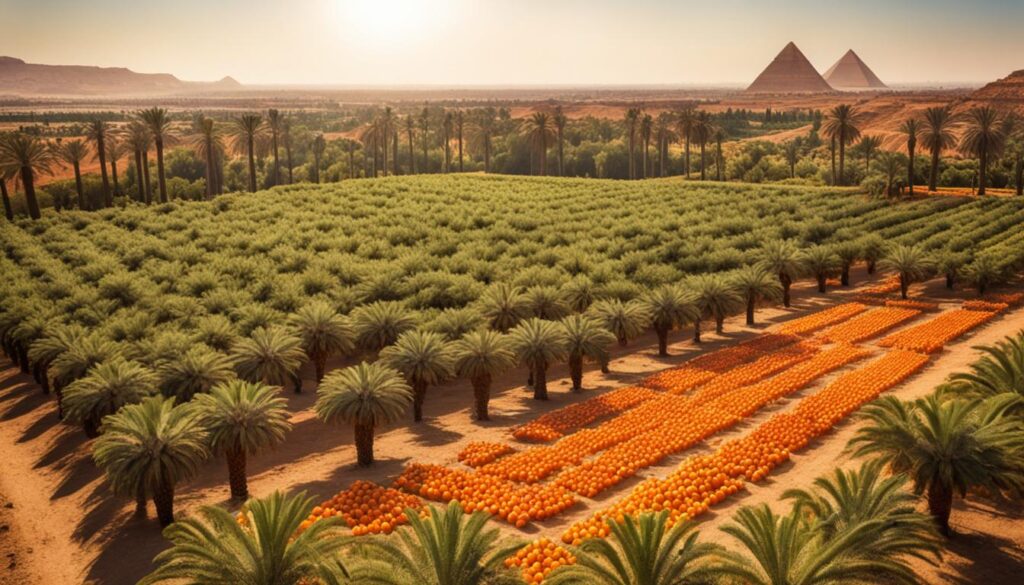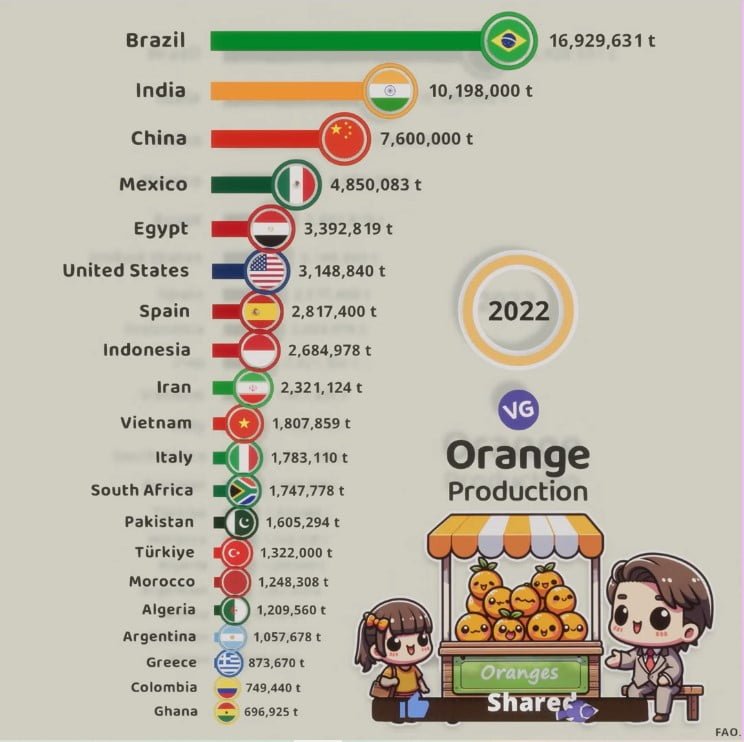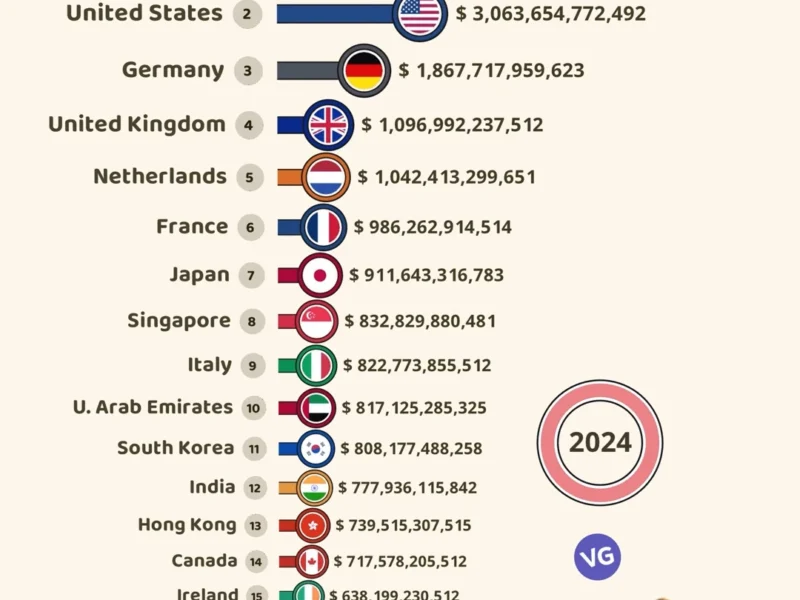The Food and Agriculture Organization says 78.7 million metric tons of oranges were produced in 20211. The leading countries in orange production are Brazil, India, China, Mexico, and the United States1. Together, they make over 75% of all oranges worldwide1. Oranges are very important for the economy and many people’s jobs. They bring money to many countries and help local areas grow. Plus, oranges are a key source of nutrition and income for families everywhere.
| Country | Orange Production (t) | Flag |
|---|---|---|
| Brazil | 16,929,631 | 🇧🇷 |
| India | 10,198,000 | 🇮🇳 |
| China | 7,600,000 | 🇨🇳 |
| Mexico | 4,850,083 | 🇲🇽 |
| Egypt | 3,392,819 | 🇪🇬 |
| United States | 3,148,840 | 🇺🇸 |
| Spain | 2,817,400 | 🇪🇸 |
| Indonesia | 2,684,978 | 🇮🇩 |
| Iran | 2,321,124 | 🇮🇷 |
| Vietnam | 1,807,859 | 🇻🇳 |
| Italy | 1,783,110 | 🇮🇹 |
| South Africa | 1,747,778 | 🇿🇦 |
| Pakistan | 1,605,294 | 🇵🇰 |
| Türkiye | 1,322,000 | 🇹🇷 |
| Morocco | 1,248,308 | 🇲🇦 |
| Algeria | 1,209,560 | 🇩🇿 |
| Argentina | 1,057,678 | 🇦🇷 |
| Greece | 873,670 | 🇬🇷 |
| Colombia | 749,440 | 🇨🇴 |
| Ghana | 696,925 | 🇬🇭 |
Key Takeaways
- Global orange production reached 78.7 million metric tons in 2021.
- The top 5 orange producing countries are Brazil, India, China, Mexico, and the United States.
- Oranges contribute to over 50% of global citrus production.
- Orange production and consumption have grown at a 3.5% rate over the past 3 decades.
- Brazil is the world’s largest orange producer, accounting for 30% of global output.
The Biggest Orange Producers in The World
Orange Production by Country (2022)
Source: FAO
Many countries produce a lot of oranges, thanks to their great weather and traditions2. Brazil leads all, making over 16 million metric tons a year, way more than any other place2. After Brazil, top producers include India, China, Mexico, and the United States. They make between 4 to 10 million metric tons each every year. Together, they supply over 75% of the world’s oranges, showing their huge impact2.
In the orange world, Brazil is king, but others are important too2. Florida in the United States expects to grow to 2.5 million metric tons soon2. Mexico also expects growth, aiming for 4.9 million tons. Turkey and South Africa are also growing. Turkey’s oranges will increase to 1.7 million tons. And South Africa hits record exports yearly2.
| Country | Orange Production (million metric tons) |
|---|---|
| Brazil | 16.0 |
| India | 8.8 |
| China | 7.2 |
| Mexico | 4.9 |
| United States | 2.5 |
These top orange producers really rule the industry, not just in growing oranges but in making juice too2. Brazil, for example, does most of the world’s orange juice exports2. And China keeps growing, expecting 26.9 million tons of tangerines and mandarins soon2.
Whether in Brazil’s sunny fields or China’s lively orchards, these top producers are making the world love oranges more and more every day234.
Brazil: The Juicy Giant of Orange Production
Brazil leads the world in growing oranges, producing over 16 million metric tons a year5. Its perfect climate and top regions help grow many types of oranges. These oranges meet needs at home and abroad.
Climate and Growing Regions
Brazil has a warm, rainy climate that’s great for growing oranges5. The states of São Paulo and Minas Gerais produce most of Brazil’s oranges. They’re in the southeast part of the country.
Varietals and Export Markets
Brazil’s farmers grow many kinds of oranges, including Pera, Valencia, Natal, and Hamlin5. Even though Brazil is the top orange producer, it doesn’t export a lot. Most of its oranges go to making juice at home6.
Still, there’s a big world market for Brazilian oranges. Their quality and steady supply make them popular7. Yet, there are challenges like changing harvests, diseases, and higher costs. This is pushing some to make more mandarin juice instead6.
Brazil faces challenges, but still leads the orange market567. It keeps working on new ideas and staying green. This way, it will stay an orange powerhouse.
United States: America’s Citrus Powerhouse
The United States is the world’s fourth-largest orange producer, making over 4 million metric tons every year8. Most of this fruit comes from sunny places like California and Florida. These states lead in the country’s orange growing efforts8.
However, the US doesn’t lead in orange exports. It ships only about 500,000 metric tons of fresh oranges yearly8. Its main export markets are South Korea, Canada, and China-Hong Kong8. American orange growers face hurdles in some countries due to tariffs and rules on plant health.
| US Orange Production by State | Production (million metric tons) |
|---|---|
| California | 2.2 |
| Florida | 1.8 |
| Texas | 0.2 |
| Arizona | 0.1 |
In the early 19th century, citrus farming in the US began8. A Frenchman named Jean-Louis Vignes bought 104 acres near the original Pueblo de Los Angeles in 1831. He started growing grapes, oranges, and lemons8. By the 1840s, another man, William Wolfskill, had the biggest citrus farm in North America with grapefruits, oranges, and lemons8.
Over the years, California’s citrus industry really bloomed. For instance, the number of lemon trees went from 62,000 in 1882 to 800,000 in 19018. People loved the Lisbon and Eureka lemons in Southern California. By the 1930s, films and citrus were California’s top exports8.
“The US is a key player in the global orange market. But, it needs to improve its exporting game. Tariffs and rules are tough, so American growers must find new ways to sell abroad.”
China: Rising Star in the Orange Industry
China is now a major player in the orange world, making about 7.7 million metric tons yearly. It holds the third spot globally9. The country’s big size and various climates support growing lots of orange types. Places like Guangxi, Yunnan, and Sichuan are known for this9. China meets its own orange needs and sends more fresh oranges abroad. It serves markets like Russia, South Korea, and Southeast Asia well9.
Geographical Advantages
China’s large and diverse land is perfect for growing oranges. It ranges from subtropical areas in the south to temperate zones in the north, allowing a wide variety of orange types to thrive9. Thanks to both its natural setting and farming technology, China has become key in growing, producing, and exporting oranges. China orange production, China orange exports, and China orange growing regions all benefit from this.
Domestic and International Demand
In China, the love for oranges keeps growing. This has pushed the nation to also become a big orange seller abroad9. Even with its large production, China also imports many oranges. The U.S. and South Africa are big sources. This helps meet the country’s high demand for oranges9.
As China upgrades its farming and finds new growing spots, it’s becoming even more important in the orange market9. China’s huge farming ability, different cultivation methods, and an expanding export scene shows its growing lead in the global citrus market9.
Spain: The Mediterranean Orange Oasis
Spain is the sixth largest orange producer, making over 3.6 million tons every year10. Its spot in the Mediterranean, great climate, and fertile lands make it perfect for growing oranges. This has made Spain a top place for orange farming.
Valencia, Andalusia, and Murcia are key areas for oranges thanks to the Mediterranean weather11. They grow many types like Navel, Valencia, and Sanguinello. Each one has its own unique taste and look.
Spain ships out 1.3 million tons of fresh oranges yearly to Europe and others10. Its great location and transport systems make it a key point for shipping citrus in Europe and abroad.
Orange farming in Spain started centuries ago. The sour orange, lime, and pummelo came in the 10th century, after Islamic rule began12. Sweet oranges joined in the 15th century, thanks to trade with Genoa and Portugal12. The mandarins arrived much later, in the early 19th century12.
Today, Spain leads in oranges, focusing on new ideas and saving the earth. Its perfect weather, key spot, and citrus history make it the “Mediterranean Orange Oasis.”101211
Mexico: The Vibrant Citrus Neighbor
Mexico is the world’s fourth-biggest orange producer. Every year, it makes over 4.5 million metric tons of oranges13. This makes Mexico stand out in the citrus world.
Traditional Cultivation Methods
In Mexico, they mix old and new ways to grow oranges. Mainly found in Veracruz, Tamaulipas, and San Luis Potosi, these places have the right climate for oranges14. Even with today’s technology, many farmers still use old methods. They keep traditions alive and benefit from the area’s farming history.
Role in the Global Market
Mexico sells a lot of oranges domestically and internationally, especially to the U.S14.. It’s close to a big orange buyer, making Mexico very important in the orange world14. Its location and traditional farming help Mexico keep its top spot in the citrus industry.

“Mexico’s orange industry is a testament to the country’s rich agricultural heritage and its ability to adapt to the changing global citrus market.”
The orange business in Mexico brings in money and is a big part of its culture15. It gives jobs to many people in Mexico. This helps support lots of families and towns15.
Even with tough times like up-and-down sales and weather issues, Mexico’s orange industry stays strong. It shows Mexico’s determination to be a leader in oranges around the world14. Mixing old farming ways with new ideas, Mexico offers delicious oranges to everyone141513.
India: The Fragrant Oranges of the Subcontinent
India is the world’s second-largest orange producer, growing over 10 million metric tons each year16. Most of these oranges come from places like Maharashtra, Madhya Pradesh, and Nagpur. These areas are famous for their top-quality and sweet-smelling oranges16. The country grows many types, including the Nagpur Santra, Mosambi, and Jaffa. Even though many oranges stay in India, more are now being sent abroad because people worldwide love their amazing smell and health benefits.
In India, the word for orange is “naranga,” showing its link to the flower’s scent. The part “nar” in Tamil means smell17. Oranges and other citrus fruits come from South Asia, East Asia, Southeast Asia, Melanesia, and Australia. People started moving these fruits during the Austronesian expansion age (around 3000–1500 BCE)17. Over time, they went to Micronesia and Polynesia, and then through trade into the Middle East, the Mediterranean (around 1200 BCE), Europe, and the Americas17.
India’s top place in growing oranges comes from the hard work in its agriculture18. Ikisan and other groups are helping with technology to improve how oranges are sold. They work with some organizations to help the orange industry grow. Ikisan and XLRI have a special program to make sure people who work with oranges have the right knowledge. This makes the Indian orange industry even stronger18.
| India Orange Production | Major Orange Producing States | Key Orange Varieties |
|---|---|---|
| Over 10 million metric tons annually16 | Maharashtra, Madhya Pradesh, Nagpur | Nagpur Santra, Mosambi, Jaffa |
The sweet smell and great taste of Indian oranges are loved worldwide. This industry is only going to do better in the future.
“The term ‘naranga’ for orange in India is derived from the fragrance of orange flowers, with the prefix ‘nar’ in Tamil referencing smell.”17
Egypt: Oranges from the Land of the Pharaohs
Egypt is a top producer and exporter of oranges with a rich history back to the days of the Pharaohs19. Its climate and the Nile’s water help its orange industry succeed19. Also, its location makes it easy to sell oranges to Europe and the Middle East19.
Historical Significance
Oranges have grown in Egypt since ancient times, reaching back to when the Pharaohs ruled19. They are very important in Egyptian culture and economy even today, being a key part of farming.
Modern Production Techniques
Today, Egyptian orange growers use advanced methods to meet the world’s orange demand20. These methods are helping the economy, with farming making up a big part of it. In 2021, Egypt sold lots of citrus fruits, with orange exports worth US$843 million20.
Egypt is a big orange exporter, with most of its citrus being oranges20. Countries like Russia and Ukraine buy a lot of Egyptian oranges20. But, bad weather is expected to lessen the next orange season in Egypt by 16%20. To fight this, Egyptian farmers are working hard, updating their farms and improving on their losses after harvest20.

Even with difficulties, Egypt is a leading power in the orange industry thanks to its history, climate, and location192021.
“Egypt’s oranges are renowned for their exceptional quality and flavor, making them a highly sought-after commodity in global markets.”
Italy: The Sweet Essence of the Mediterranean
Italy is the second-biggest orange producer in Europe after Spain22. It has a big role in the world’s citrus industry. With its warm Mediterranean weather and fertile soil, areas like Sicily, Calabria, and Campania grow many types of oranges. These oranges are famous for their sweet taste and rich flavor.
The Tarocco, Moro, and Sanguinello oranges are very popular in Italy22. They are loved at home and abroad. Italy benefits from being close to Europe for selling these oranges.
Sicily is a big lemon producer in Italy22. The bergamot orange, known for its use in making perfumes, mainly grows in Calabria and Sicily22. These regions are the top producers of bergamot in the world. Bergamot fruits are harvested between December and March22. Their oil is greatly desired for various perfumes.
Even though Italy is known for its oranges, it has some challenges too23. Diseases affect its citrus groves. Italy is putting a lot of money into disease research to help its crops.
Italy’s citrus farming traditions and special oranges help it stand out in the world22. As people everywhere want high-quality oranges, Italy stays important as a top producer.
Conclusion: The Global Citrus Landscape
Oranges are key in farming around the world. The number of oranges grown and eaten keeps rising24. Several countries, like Brazil, India, and the U.S., make most of the oranges. They make up over 75% of all oranges produced. But, other places such as Egypt and South Africa send lots of oranges to customers all over the world25.
People want more healthy and eco-friendly food. This is good news for the orange world. Global orange production and trade are doing well. The industry looks like it will grow even more2425.
More oranges are being eaten all over the globe. Health-focused folks are driving this change. So, the orange and citrus world will keep changing. Big and small players will work hard to meet these new needs2425.
The orange world’s mix and energy show how huge it is for farming. With every challenge and chance, the future of citrus looks bright. Both for those who grow, sell, and eat oranges26.
FAQ
What are the top orange producing countries in the world?
Brazil, India, China, Mexico, and the United States are the leading orange producers. More than three-quarters of the world’s oranges come from them.
Which country is the largest producer of oranges globally?
Brazil leads the world in orange production. It grows over 16 million metric tons a year. This is more than any other country.
What are the major orange producing regions in Brazil?
Brazil grows many kinds of oranges in states like São Paulo and Minas Gerais. Some famous types are Pera, Valencia, Natal, and Hamlin.
How much of Brazil’s orange production is used for domestic orange juice production?
About: While Brazil is a top grower, it uses most oranges for juice in the country. It makes a lot of orange juice for its people and is the top seller of frozen juice. But, it sends out only a little fresh fruit.
What are the main orange producing regions in the United States?
The US grows a lot of oranges in California and Florida. These areas make up most of the orange crop.
Where does the United States export its oranges?
The US sells many oranges to South Korea, Canada, and China-Hong Kong. However, trade rules in some places make it hard for the US to sell more oranges.
How has China’s role in the global orange industry evolved?
China now stands as a top orange producer, making almost 7.7 million tons a year. It is the third-largest source of oranges. Besides meeting local needs, it sells to other countries like Russia, South Korea, and Southeast Asia.
What is Spain’s role in the global orange trade?
Spain comes in sixth for global orange production, making over 3.6 million tons a year. It’s a big seller of fresh oranges, sending out more than 1.3 million tons yearly. It ships oranges to places in Europe and beyond.
How does Mexico’s proximity to the United States impact its role in the global orange market?
Mexico, close to the US, is a major orange supplier. It sells a lot of fresh oranges, mainly to its neighbor to the north. This makes Mexico a key player in the orange market worldwide.
What are the key orange-producing regions in India?
Maharashtra, Madhya Pradesh, and Nagpur are key areas for India’s orange production. These places are known for growing tasty and top-quality oranges.
How has Egypt’s role in the global orange trade evolved?
Egypt is the seventh top orange producer, making 3 million tons a year. It ships over half of its oranges mainly to Europe. This is because of its good location and ports.
What are the notable orange varieties cultivated in Italy?
In Italy, places like Sicily, Calabria, and Campania are great for various orange types. They grow favorites like Tarocco, Moro, and Sanguinello oranges.
Source Links
- Top Orange Producing Countries In The World
- The Citrus Industry in Florida – Division of Historical Resources
- Facts About Florida Oranges & Citrus | VISIT FLORIDA
- Orange Production By Country (Top 118 Countries)
- Here’s Why Orange Juice Is Ridiculously Expensive Right Now
- Orange (fruit)
- Yes, we know about oranges in LA history — but lemons had some juice too
- Mandarin orange
- Suntory Holdings and Suntory Beverage & Food Europe Sign New Partnership with CIRAD to Tackle Global Orange Disease
- The Citrus Industry
- No title found
- Citrus Production – an overview
- An ode to citrus
- The Roots of Inequality: The Citrus Industry Prospered on the Back of Segregated Immigrant Labor – Fullerton Observer
- An Orange Letdown
- Citrus
- No title found
- The Timeless Love Affair: A Journey through Orange Fruit History in Egypt since Ancient Egyptians
- Egypt: The world’s biggest exporter of oranges
- The rise and rise of Egypt’s orange production | Janine Ryan – DiscountMags.com
- THE ZESTY FLAVOUR OF SOUTHERN ITALY – Ultra International B.V.
- The orange fruit and its products
- Global Citrus Oil Market: Latest 2024 Report & Forecast by 2032 | Survey With 110 Pages
- Citrus Extract Market Global Size, Growth | Global Report, 2032
- Global Citrus Oil Market Landscape 2023-2028: Rising Demand for Natural and Eco-Friendly Cleaning and Household Products Presents Opportunities
- Top Orange Producing Countries In The World
- The Citrus Industry in Florida – Division of Historical Resources
- Facts About Florida Oranges & Citrus | VISIT FLORIDA
- Orange Production By Country (Top 118 Countries)
- Here’s Why Orange Juice Is Ridiculously Expensive Right Now
- Orange (fruit)
- Yes, we know about oranges in LA history — but lemons had some juice too
- Mandarin orange
- Suntory Holdings and Suntory Beverage & Food Europe Sign New Partnership with CIRAD to Tackle Global Orange Disease
- The Citrus Industry
- No title found
- Citrus Production – an overview
- An ode to citrus
- The Roots of Inequality: The Citrus Industry Prospered on the Back of Segregated Immigrant Labor – Fullerton Observer
- An Orange Letdown
- Citrus
- No title found
- The Timeless Love Affair: A Journey through Orange Fruit History in Egypt since Ancient Egyptians
- Egypt: The world’s biggest exporter of oranges
- The rise and rise of Egypt’s orange production | Janine Ryan – DiscountMags.com
- THE ZESTY FLAVOUR OF SOUTHERN ITALY – Ultra International B.V.
- The orange fruit and its products
- Global Citrus Oil Market: Latest 2024 Report & Forecast by 2032 | Survey With 110 Pages
- Citrus Extract Market Global Size, Growth | Global Report, 2032
- Global Citrus Oil Market Landscape 2023-2028: Rising Demand for Natural and Eco-Friendly Cleaning and Household Products Presents Opportunities



